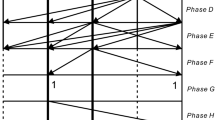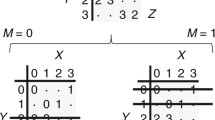Abstract
Quantum entanglement, perhaps the most non-classical manifestation of quantum information theory, cannot be used to transmit information between remote parties. Yet, it can be used to reducethe amount of communication required to process a variety of distributedcomputational tasks. We speak of pseudo-telepathy when quantum entanglementserves to eliminate the classical need to communicate. In earlier examples of pseudo-telepathy, classical protocols could succeedwith high probability unless the inputs were very large. Here we present a simple multi-party distributed problem for which the inputsand outputsconsist of a single bit per player, and we present a perfectquantum protocolfor it. We prove that no classical protocol can succeedwith a probability that differs from 1/2 by more than a fraction that is exponentially small in the number of players. This could be used to circumvent the detection loophole in experimental tests of nonlocality.
Access this chapter
Tax calculation will be finalised at checkout
Purchases are for personal use only
Preview
Unable to display preview. Download preview PDF.
Similar content being viewed by others
References
Aaronson, S., Ambainis, A.: Quantum search of spatial regions. Available as arXiv:quant-ph/0303041 (2003)
Bennett, C.H., Brassard, G., Crépeau, C., Jozsa, R., Peres, A., Wootters, W.K.: Teleporting an unknown quantum state via dual classical and Einstein–Podolsky–Rosen channels. Physical Review Letters 70, 1895–1899 (1993)
Brassard, G.: Quantum communication complexity. Foundations of Physics (2003) (to appear)
Brassard, G., Cleve, R., Tapp, A.: Cost of exactly simulating quantum entanglement with classical communication. Physical Review Letter 83, 1874–1878 (1878)
Buhrman, H., Cleve, R., Wigderson, A.: Quantum vs. classical communication and computation. In: Proceedings of 30th Annual ACM Symposium on Theory of Computing, pp. 63–68 (1998)
Cleve, R., Buhrman, H.: Substituting quantum entanglement for communication. Physical Review A 56, 1201–1204 (1997)
Gould, H.W.: Combinatorial Identities. Morgantown (1972)
Kalyanasundaram, B., Schnitger, G.: The probabilistic communication complexity of set intersection. In: Proceedings of 2nd Annual IEEE Conference on Structure in Complexity Theory, pp. 41–47 (1987)
Massar, S.: Non locality, closing the detection loophole, and communication complexity. Physical Review A 65, 032121-1–032121-5 (2002)
Nielsen, M.A., Chuang, I.L.: Quantum Computation and Quantum Information. Cambridge University Press, Cambridge (2000)
Raz, R.: Exponential separation of quantum and classical communication complexity. Proceedings of 31st Annual ACM Symposium on Theory of Computing, pp. 358–367 (1999)
Yao, A. C.–C.: Probabilistic computations: Toward a unified measure of complexity. Proceedings of 18th IEEE Symposium on Foundations of Computer Science, pp. 222–227 (1977)
Yao, A.C.-C.: Quantum circuit complexity. In: Proceedings of 34th Annual IEEE Symposium on Foundations of Computer Science, pp. 352–361 (1993)
Author information
Authors and Affiliations
Editor information
Editors and Affiliations
Rights and permissions
Copyright information
© 2003 Springer-Verlag Berlin Heidelberg
About this paper
Cite this paper
Brassard, G., Broadbent, A., Tapp, A. (2003). Multi-party Pseudo-Telepathy. In: Dehne, F., Sack, JR., Smid, M. (eds) Algorithms and Data Structures. WADS 2003. Lecture Notes in Computer Science, vol 2748. Springer, Berlin, Heidelberg. https://doi.org/10.1007/978-3-540-45078-8_1
Download citation
DOI: https://doi.org/10.1007/978-3-540-45078-8_1
Publisher Name: Springer, Berlin, Heidelberg
Print ISBN: 978-3-540-40545-0
Online ISBN: 978-3-540-45078-8
eBook Packages: Springer Book Archive




